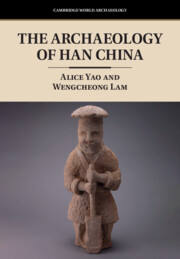Book contents
- The Archaeology of Han China
- Cambridge World Archaeology
- The Archaeology of Han China
- Copyright page
- Contents
- Plates
- Figures
- Tables
- Acknowledgements
- Introduction
- Part I Imperial Geography
- 1 Imperial Geography of the Capital and Core Macro-Regions
- 2 Imperial Geography and Border Formations in the Ordos and Lingnan Regions
- Part II Food Production and Foodways
- Part III Crafts
- Part IV Death Ritual
- Glossary of Chinese Names and Places
- References
- Index
- Plate Section (PDF Only)
2 - Imperial Geography and Border Formations in the Ordos and Lingnan Regions
from Part I - Imperial Geography
Published online by Cambridge University Press: 12 December 2024
- The Archaeology of Han China
- Cambridge World Archaeology
- The Archaeology of Han China
- Copyright page
- Contents
- Plates
- Figures
- Tables
- Acknowledgements
- Introduction
- Part I Imperial Geography
- 1 Imperial Geography of the Capital and Core Macro-Regions
- 2 Imperial Geography and Border Formations in the Ordos and Lingnan Regions
- Part II Food Production and Foodways
- Part III Crafts
- Part IV Death Ritual
- Glossary of Chinese Names and Places
- References
- Index
- Plate Section (PDF Only)
Summary
Chapter 2 compares patterns of population growth and settlement organization of the Ordos and Lingnan – two frontier regions – in a diachronic framework to argue for the transformation of frontier zones into extended networks and bounded territories in the middle Western Han. The Great Wall is reprised as a spatial infrastructure that is central to understanding Han imperialism as both an economic enterprise and a form of settler colonialism.
- Type
- Chapter
- Information
- The Archaeology of Han China , pp. 59 - 88Publisher: Cambridge University PressPrint publication year: 2024

